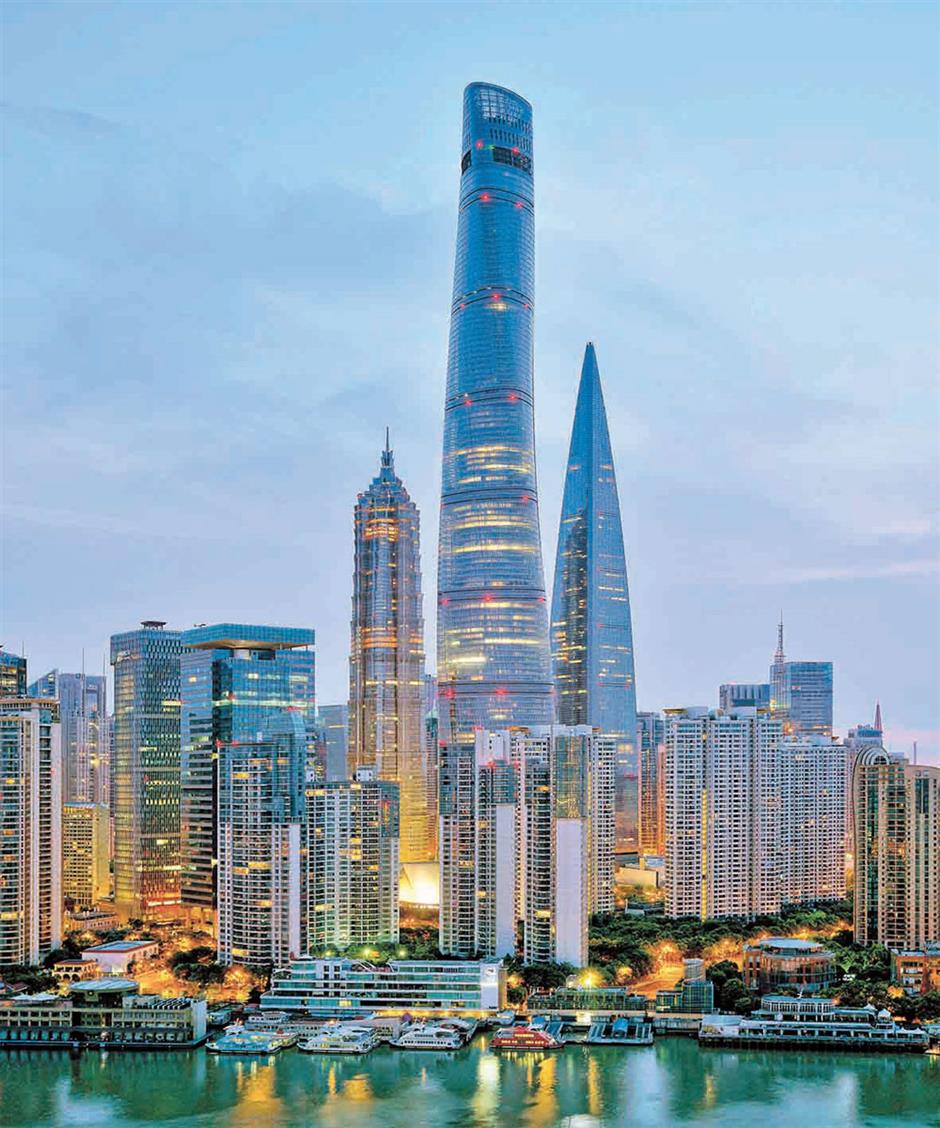Shanghai Tower goes from strength to strength

Twisting 632 meters above the Lujiazui financial hub, Shanghai Tower is the tallest building in China and the second tallest in the world.
Glittering skyscrapers have sprung up all over the city, but Shanghai Tower stands tallest, and not only because of its height.
Shanghai Tower redefines what a supertall building can achieve through environment-friendly design, creating the concept of “sustainable vertical urbanism,” a paradigm for future megacities.
Twisting 632 meters above the Lujiazui financial hub, the “crystal spiral” is the tallest building in China and the second tallest in the world, surpassed only by the 828-meter Burj Khalifa in Dubai. Covering 578,000 square meters, it has 127 floors above the ground, five underground and holds several world records. It features the world’s heaviest damper, with a weight of 1,000 tons.
Weighing 850,000 tons, it is built on soft ground and is widely regarded as the world’s greenest skyscraper.
The first building in the world over 400 meters to be awarded the top green rating, a platinum-level leadership in energy and environmental design certificate by the US Green Building Council, it also holds a National Green Building Label from the Ministry of Housing and Urban-Rural Development.

Shanghai Tower was chosen as one of the best tall buildings in the world in 2016 by the Council on Tall Buildings and Urban Habitat.
Green building
Shanghai Tower incorporates more than 40 energy-saving features, which have reduced the tower’s energy consumption by 20 percent since it was put into use. Last year, its carbon dioxide emissions fell by 11,000 tons, as effective as 100,000 30-year-old fir trees.
The building collects rainwater used for gardens, toilets, and cooling and heating systems. The rain collection system can recycle 25 percent of rainwater and supplies 245,000 cubic meters of water to the tower every year, reducing the tower’s water consumption by 53 percent. There are 270 wind turbines spinning at the top of the tower, which can generate up to 1.19 million kwh of green power per year, about 10 percent of that needed.
The building is wrapped in two layers of glass for natural cooling and ventilation. Plants and trees on the rooftop increase the rain seepage rate and help to keep it cool in the summer. And inside there are more than 20 gardens, including one in an elegant Suzhou style.
To encourage people to use cars with lower emission, the tower has many parking spaces for new-energy cars in premium locations, close to elevators.
Vertical community
Not only a paragon of ecological design, the vertically integrated community stacks shops, offices and cafes on a vertical plane, redefining previously horizontal urban communities.
The tower was chosen as one of the best tall buildings in the world in 2016 by the Council on Tall Buildings and Urban Habitat.
In the citation, the CTBUH said that Shanghai Tower showed the greatest commitment to communal space in a tall building and contained the world’s first truly inhabitable double-skin facade on a skyscraper, remarkable for its incorporation into the tower’s overall ventilation strategy. The tower has nine “vertical communities,” each of which covers 12 to 15 floors.
Every community has “sky lobbies” which are participatory spaces between the layers of the double-skin façade. They function as an open-air square of a town where people gather, talk and dine. Tenants don’t need to take elevators downstairs to have a cup of coffee or buy a sandwich, which, naturally and obviously, saves electricity.
Offices from the eighth to the 81st floors, are divided into five “vertical communities,” and have attracted the regional headquarters of multinational companies.
Cultural landmark
Shanghai Tower is also a cultural landmark. The 37th floor is home to Shanghai Guanfu Museum with thousands of antiques including ceramics, porcelain, gold, Buddhist statues and furniture. On the same level is a 480-square-meter enamel floor, the world’s biggest.
On the 38th floor is the Baoku Jiangxin Art Center that exhibits a wide range of craftsmanship including jade, silk embroidery and Thangka paintings.
About 25 meters underground Shanghai Tower accommodates the world’s largest non-bank underground safety vault for art and antiques.
The tower has hosted TEDxShanghai, Shanghai International Film Festival events, the final of 2016 Miss Universe China and the 2017 Shanghai Tower International Vertical Marathon.
Currently, the tower is holding a Dunhuang grottoes exhibition that will last February next year. Three full-size replicas of grottoes from Dunhuang, an oasis town in northwest China, are the highlight of the exhibition. The replicas, two from the Mogao grottoes and one from the Yulin grottoes, are reproduced using high-definition scanning and 3D printing.
The exhibition also features 120 antiques from museums in northwest China’s Gansu Province, many of which are on display in Shanghai for the first time. They include the duplicate statue “Bronze Galloping Horse Treading on a Flying Swallow” from the Eastern Han Dynasty (AD 25-220).
Popular destination
Today, Shanghai Tower is an inevitable mark in the city’s sightseeing map and has received more than 1 million visitors.
A visit to the tower starts underground where visitors get to know the design and highlights of the tower. Then, it takes only 55 seconds to send visitors to the observatory on the 118th floor at the height of 546 meters, thanks to the world’s fastest elevators. Visitors are treated to a 360-degree view of the city skyline and can have fun through VR activities.
On the 125th floor, there stands the giant 1,000-ton damper. Visitors can get to know how it operates through multimedia installations and interactive experiences.
The tower is also an ideal place to hold meetings and business events. To ensure quality of services, the building’s operation team was recruited from five-star hotels. It has the largest banqueting ball in the Pudong New Area and a ballroom with a garden outside, a conference hall with an exclusive sun room and seven meeting rooms.
Exclusive VIP elevators, VIP lounges and other facilities are there for guests who value their privacy.
















